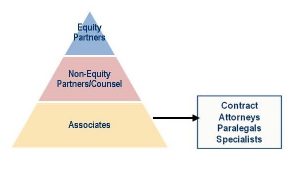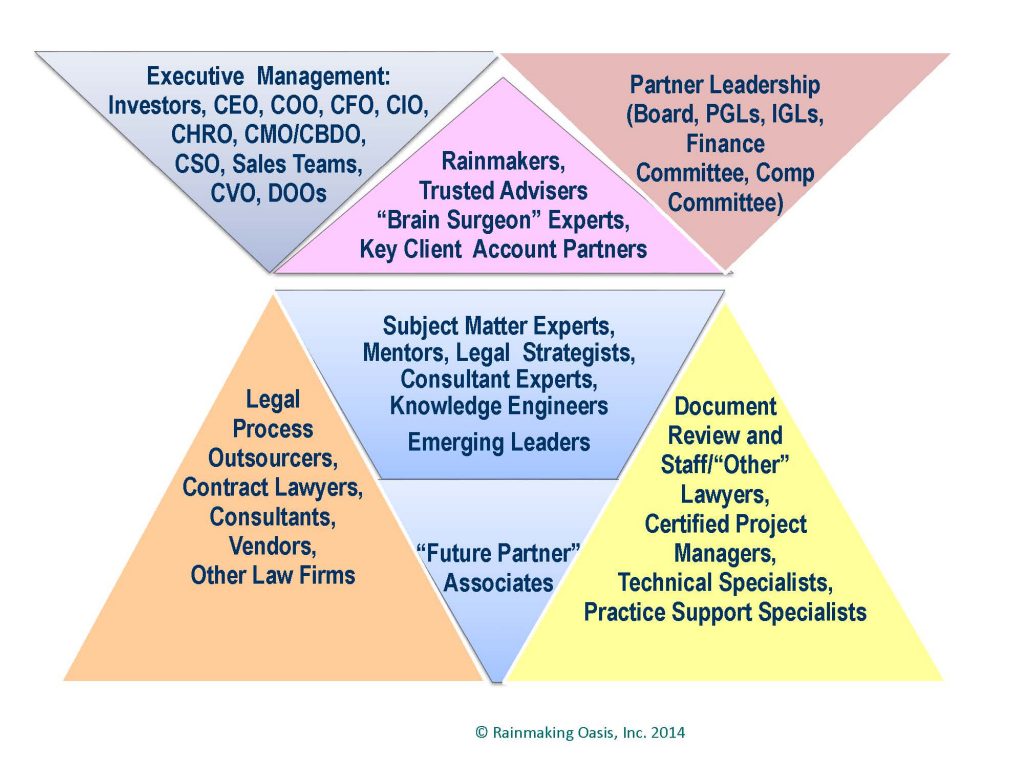Part 1 of 3: The Next Normal – Will the Traditional Law Firm Model Survive?
 This article is the first in a series to look at the “Next Normal” for law firms. Part 1 focuses on the traditional law firm model and why it is unlikely to remain as it is, Part 2 focuses on lawyer skills and talent management in the future, and Part 3 will address whether and how traditional law firms can adapt to meet these challenges.
This article is the first in a series to look at the “Next Normal” for law firms. Part 1 focuses on the traditional law firm model and why it is unlikely to remain as it is, Part 2 focuses on lawyer skills and talent management in the future, and Part 3 will address whether and how traditional law firms can adapt to meet these challenges.
If ” traditional” encompasses the status quo — incentives that measure and reward billable hours, a pyramid structure where large numbers of associates are hired, weeded out and then promoted to the partnership by doing really good work and putting in excessive hours, where client matters are each approached in a bespoke manner — the answer to the title question is “no.” Looking ten to twenty years into the future, law firms that adhere to (or stay mired in) traditional models of structure, service delivery, staffing and management, will be eclipsed by more nimble, adaptable organizations that deliver the services and solutions that clients need, more effectively. While some firms may survive in the traditional mold, we will see many more implode, be acquired or simply close their doors. Those that survive as “winners” will more aggressively and dramatically change the way they do business.
The Traditional/Current Model

Many aspects of this traditional model are breaking down. What was once a “cash cow” for firms — hiring large number of associates who work and bill 2000 hours per year and who in their third through eighth or tenth year contirbuted significantly to a firm’s profits is no longer a viable model. Most clients today refuse to pay for first or second year associates and many of the lower level work done by associates is now being sent to alternative service providers. It therefore makes little sense for firms to continue to hire large classes of associates, even if the assumption is that two thirds or more would volunatarily leave or be weeded out by their fifth year, which again, has been common practice until the last several years.
Traditional Partnerships are Elusive
In many firms, the value and meaning of partnership has changed, especially since it no longer carries with it the security of tenure it once did. As partners are de-equitized or encouraged to leave their firms if they are not producing, and as lateral partners with books of business who command high compensation and guarantees continue to be the growth strategy of choice, loyal, collaborative partnerships are much more difficult to find, build or sustain. The emphasis is on business generation and profitability; there is little tolerance for even a year or two of low billable hours and certainly of partners who don’t or can’t bring in new clients.
Because equity partner ranks are shrinking, most firms have seen their category of non-equity partner and counsel grow. This is creating numerous problems. One is that firms now are still too top heavy – there are large numbers of senior lawyers not originating new business, serving as service lawyers, and often not significantly enhancing the revenue of the firms. Another outcome as evidenced in a recent Peer Monitor survey shows that equity partners billable hours exceeded hours of non-equity partners, counsel/of counsel/special counsel by 300 hours/year in 2013. This reflects that there likely is not enough work to go around and some equity partners are hording work, most likely for compensation credit. Finally, this bloated layer of senior lawyers between partners and associates creates a log jam for talented associates who aspire to partnership.
How Legal Work is Viewed and Valued has Changed
As evidenced by what clients are and are not willing to pay ever-higher rates for, much of the work traditionally done by law firms has diminished in value. There will always be a need to justify to key stakeholders that as a GC, you have hired the best, but outside legal spend devoted to “bet-the-company” cases or deals typically represents only 3-5% of the work in-house counsel send out (although it typically represents a much higher proportion of the spend.) The remaining ninety-five percent most often falls into three or four other “buckets.”
- Susskind defines the buckets as: Bespoke, Standardized, Systematized, Packaged and Commoditized.
- Jeff Carr, GC at FMC Technologies believes that “Not every legal problem requires a brain surgeon. A high percentage of needs are basic blocking and tackling, and many require just a form.” He puts legal work into four buckets: Advocacy, Counseling, Content and Process and suggests that the value that lawyers bring to the table falls almost exclusively into buckets one and two, where the need for the application of judgment is highest (see prior post on Client Service and Innovation.)
- Bill Cobb of Cobb Consulting defines it as Bet the Company (4%,) Hired for Experience (16%,) Reputation and Expertise (20%,) Routine/Commoditized (60%.)
- Nabarro Report GC Value Pyramid (see Value Post 3: Like Law Firms, GCs Must Deliver More Value to Their Clients) includes a four level pyramid with Level 1 focusing on strategic business planning, change management and board influence; Level 2 focusing on complex problem solving, lead negotiater or trial lawyer on major deals/cases, crisis management; Level 3 focusing on risk mitigation, influencing business stakeholders and leading external advisers and Level 4 focusing on getting the job done well and correctly, providing legal solutions and management reporting.
Alternative service providers have proliferated to provide many content, routinized and commoditized services. These alternative service providers now offer many services that traditional firms have considered their bread and butter, e.g., research and discovery, contracts, NDAs, and patent prosecution.
Traditional Roles and Hierarchy are No Longer As Effective
There is less room at the top of the partnership and the criteria for being a profitable and successful partner have changed. The amount and type of work that clients now send out directly to alternative service providers has accelerated. Technology and automation have disrupted and in some instances replaced work that was previously done manually. This inevitably changes the roles and responsibilities of those employed by law firms.
In his most recent book, “Tomorrow’s Lawyers,” Richard Susskind suggests that lawyers will fill many different roles in the future including:
- Expert trusted adviser
- Enhanced practitioner
- Legal knowledge engineer
- Legal technologist
- Legal hybrid
- Legal process analyst
- Legal project manager
- Online Dispute Resolution practitioner
- Legal management consultant
- Legal risk manager
- Technical specialists: patent agents, economic analysts, etc.
In addition to new roles for lawyers, legal service providers of the future will employ many others types of professionals. In addition to some of those included in the list above, like process improvement and project management, others becoming more commonplace today include pricing specialists, sales professionals and client service/account managers.
So back to the initial question: will the traditional model be viable in the future? Is it the best structure? What might an organization that retains some of the traditional values and structure of a law firm partnership but adapts to the changing landscape look like going forward? Perhaps it will look something like this:

Law firms need to take a new look at what it is clients need from their firms, how they will modify or redesign their organizations to deliver those needs as effectively and efficiently as they can in order to meet their profitability goals, what type of organizational structure and culture they will need to balance their financial goals with the type of place in which they like and want to work, who and how they hire, train and reward, what business they are in or should be in, and what kind of leadership and governance structure they need to hold it all together.
Our next blog post will take a closer look at the talent needs and challenges that law firms and other employers will have in the future.

